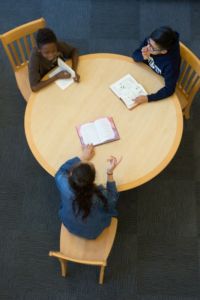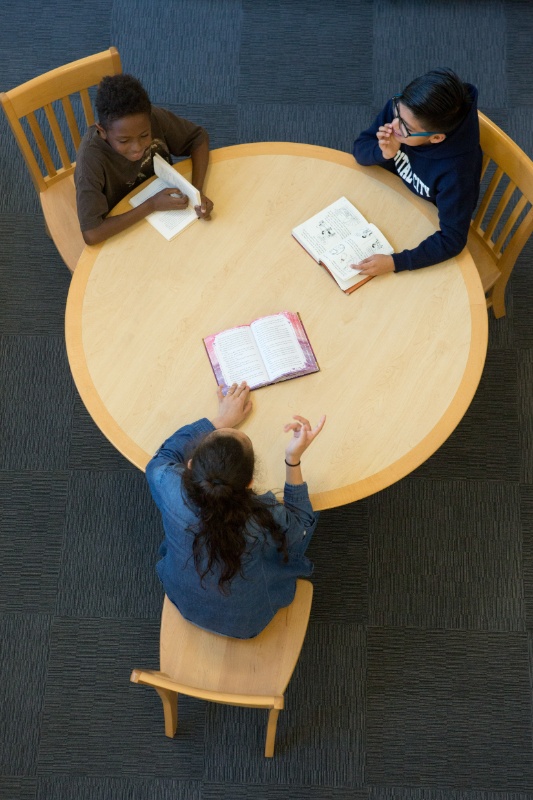
Book Talks are one of the most powerful ways to get our students interested in books. Book stores, public libraries, school libraries, classroom libraries are all BIG places if you do not eat, sleep, and breathe books all day, every day like many teachers and librarians do. Yes, we have Good Reads, book displays, book trailers, recommendations on Amazon, and card catalog software for students to use, but those can be overwhelming and intimidating as well. Our students are like us, they often prefer the personal touch. Book Talks are where we can have a captive audience to geek out on and tell them all about this book that we just read and absolutely loved. In my experience, students are almost always receptive to sitting down as a class or standing beside me individually as we go about the library and allowing me to tell them about a book, especially if I can have that book in my hand or a picture of it up on the screen behind me. Book Talks afford us the opportunity to let students know what a book is about, so that they can then in turn make informed decisions about whether that book is a good choice for them or not. But sometimes I like to approach a book talk a little bit differently. I like to invite students to do a little work, to do a little thinking, before I simply launch into a book talk. As we have been investigating in previous blogs, I believe curiosity is the key to get students excited about reading and learning. I think a great way to stimulate curiosity is through the use of pre-reading strategies. Almost all of these– KWLs, Anticipation Guides, Entrance Notes, Reading Around the Text– can be referred to as activating schema or setting expectations. They are ways to tie into students’ prior knowledge and get students excited about reading. Besides using Kahoot, which was discussed in an earlier blog, I have two strategies I like to use as a springboard to launch book talks. The first involves using everyday objects somehow related to the book. The second involves using the opening lines from the books themselves.
I like to invite students to do a little work, to do a little thinking, before I simply launch into a book talk.
As for using an object, here is an example. I want to introduce students to the young adult version of the Biography about Malala co written with Patricia McCormick. (Side note… please read the Young Adult version! The original is quite a challenging read. Adding Patricia McCormick to the writing equation is always a positive thing). I could just begin talking about it, because, after all, it’s pretty attention grabbing to talk about a young girl who is shot just because she wants to go to school. But I love inviting my students to think a little by first showing them a Nobel Peace Prize. They may or may not know what it is. They can obviously tell it is a medal, something that has been awarded, like an Olympic Medal, so I am tying into some prior knowledge, but I can also create curiosity by quite possibly introducing the new concept of the Nobel Prizes, and then when I can add that a teenager won one simply because she wanted to go to school, I have them hooked. Here are examples I’ve used with students.

The other springboard that I like to use comes from the book itself. Most authors, especially those who write for middle grades and young adults, have learned the power of a well-crafted opening sentence to hook readers. Why not use these? I like to work with five books at a time. I find five books that have particularly powerful opening lines. I do two things with these first lines. First, I put them on a PowerPoint slide so that students can see them. Second, I put them on the left-hand side of a word document. Then I use the book covers. Again, I put them on a PowerPoint slide so that students can see them, and I place them on the right hand side of a word document. As for the PowerPoint, as I am introducing our time together in the library, I tell students that as a way of meeting some new books, we are going to try to match book covers with their opening lines. I read each opening line as it appears on the screen behind me; this reaches my students who struggle with reading and reaches both my auditory and visual learners. Then I put up the slide with all of the book covers. Depending on time, we sometimes talk about the covers just a bit before I hand them the word document, which is where they will work as pairs to try and match the cover with the correct opening line. I love this particular way of introducing books because it helps my students to be active learners. They are working together, looking at the evidence of the opening text and the cover, discussing possible connections, working on their persuasive skills, and learning to reach cooperative decisions. There are many things going on in this seemingly simple matching activity. Then, when they are finished, I reveal the correct combinations, book talking each book as it comes. We celebrate those who matched all five; we celebrate those who did not match any correctly, because we are all winners when we can become curious about something new and when we can help students discover the joy of reading. So whatever works for you, objects, opening lines, or something else, may your creativity guide you; I wish you well on your journey of piquing curiosity and of connecting students with books.
Resources
Please login or register to claim PGPs.
Alternatively, you may use the PGP Request Form if you prefer to not register an account.



